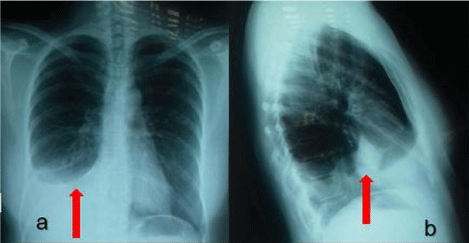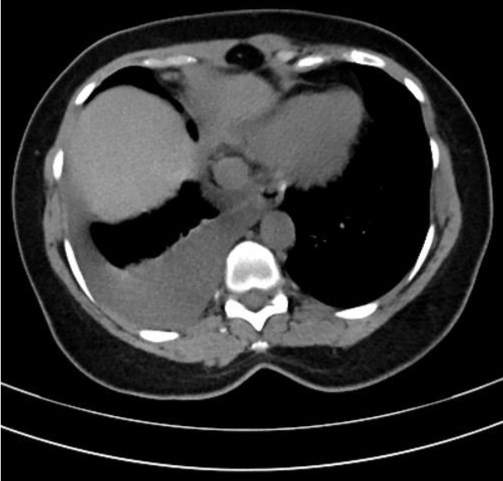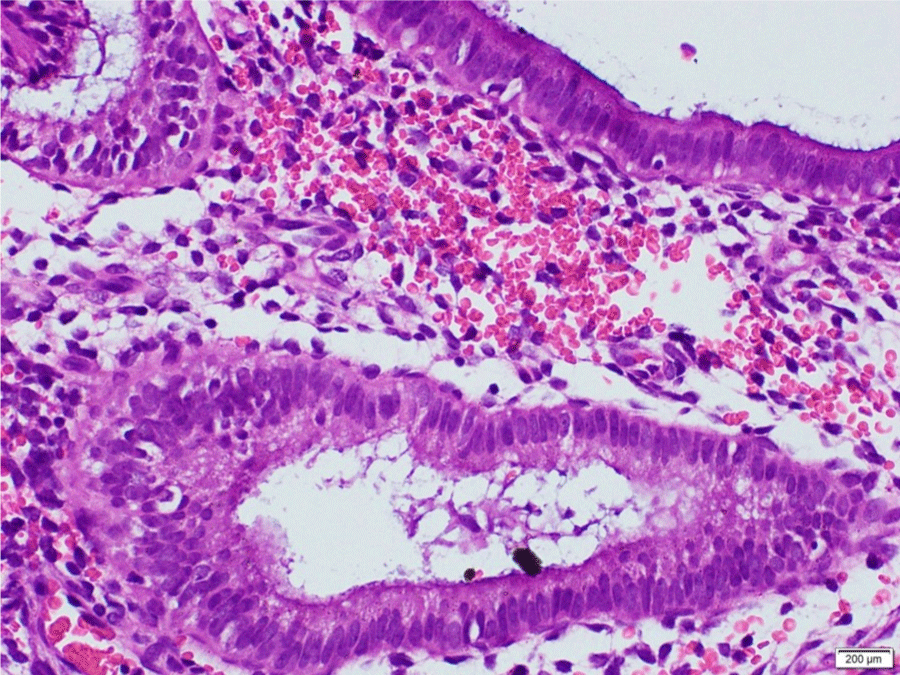This case discusses the importance of thoroughly investigating a haemorrhagic effusion in a setting where the tuberculosis is endemic.
A young woman presented with an asymptomatic recurrent right sided pleural effusion. Pleural fluid full report showed neutrophilic and haemorrhagic effusion. Adenosine deaminase level in the pleural fluid was elevated and the Mantoux test was positive. Microbiological diagnosis was negative, and she was started on anti-tuberculous therapy on clinical grounds for extrapulmonary tuberculosis. Diagnostic Thoracoscopy revealed characteristic appearance suggestive of thoracic endometriosis which was confirmed by histology.
Thoracoscopy is valuable in rapid diagnosis of pleural based diseases such as thoracic endometriosis. It also provides option to drain tuberculous and other complicated effusions completely minimising the chance of later complications. This case discusses the importance of thoroughly investigating a haemorrhagic effusion in a setting where the tuberculosis is endemic.
Haemorrhagic effusion, Catamenial haemothorax, Tuberculosis, Thoracic endometriosis syndrome
TB: Tuberculosis; TES: Thoracic Endometriosis Syndrome; BMI: Body Mass Index; CECT: Contract Enhanced Computed Tomography; ESR: Erythrocyte Sedimentation Rate; CRP: C-Reactive Protein; LDH: Lactase Dehydrogenase; ANA: Antinuclear Antibody; RF: Rheumatoid Factor; HIV: Human Immune Deficiency Virus; USS: Ultra-Sound Scan; RBC: Red Blood Cells; AFB: Acid- Fast Bacilli; ADA: Adenosine Deaminase; GeneXpert MTB/RIF: Mycobacterium Tuberculosis and Resistance to Rifampicin; BCG: Bacillus Calmette-Guérin; ATT: Anti-tuberculous Therapy; VATS: Video Assisted Thoracoscopic Surgery; SLE: Systemic Lupus Erythematosus; GnRH: Gonadotropin-Releasing Hormone
Haemorrhagic pleural effusion is defined as pleural fluid hematocrit greater than 50% of the patient's blood hematocrit. Spontaneous haemorrhagic effusions have a broad differential diagnosis which includes TB, malignancy, connective tissue disorders, pancreatic fistulas, leaking aortic aneurysms and other vascular malformations, TES, ovarian hyperstimulation syndrome etc. [1-4]. Co-existing aetiologies can lead to diagnostic and management dilemma among physicians. TB remains one of the most frequent causes of pleural effusions globally, hence always is high up in the list of differential diagnoses [5].
Endometriosis is characterised by the presence of hormone sensitive endometrial tissue outside the uterine cavity. It is more commonly encountered in the dependent parts of the pelvis such as ovaries, fallopian tubes, uterine ligaments, pelvic peritoneum, cervix, labia, and the vagina [6]. TES is a distinct category with the presence of functional endometrial tissue in or around the lung. TES has four main clinical subtypes: catamenial pneumothorax, catamenial haemorrhagic effusion, haemoptysis and pulmonary nodules.
This case discusses the importance of thoroughly investigating a haemorrhagic effusion in a setting where the prevalence of TB is high and the dilemma in diagnosis and management in the presence of TES.
A 43-year-old unmarried Sri Lankan woman working in Maldives was referred to the Respiratory Medicine unit of the National Hospital of Sri Lanka. She was diagnosed with a right sided pleural effusion in the chest X-ray performed during her annual medical screening. she had been asymptomatic preceding this incident and thereafter. An abnormality was detected in her chest X-ray one year prior to this incident but she had not been further evaluated. Her previous chest X-ray was not available but according to her, it was also a right sided abnormality. She had never smoked, and her family history was not significant for any specific medical illness. There were no clinical clues to suspect an immunocompromised status.
On examination, she was apparently healthy with a BMI of 22 Kg/m2. Respiratory examination was compatible with a moderate right sided pleural effusion. Repeat chest X-ray confirmed the persistence of an encysted effusion (Figure 1). Based on the clinical picture it was decided to continue with ATT on empirical basis which had already been started in Maldives. She was on isoniazid (10 mg/kg), rifampicin (15 mg/kg), pyrazinamide (35 mg/kg) and ethambutol (20 mg/kg) and we converted it to multidrug combination tablets. Further diagnostic investigations were planned to explore the definite diagnosis.
 Figure 1: Postero-anteror (a) and lateral (b) chest X-rays of the patient shows the pleural effusion. Lateral chest X-ray showed 'rock of Gibraltar sign'(arrow) which is characteristic of subpulmonic effusions. View Figure 1
Figure 1: Postero-anteror (a) and lateral (b) chest X-rays of the patient shows the pleural effusion. Lateral chest X-ray showed 'rock of Gibraltar sign'(arrow) which is characteristic of subpulmonic effusions. View Figure 1
The CECT scan of the thorax showed moderate to severe right sided pleural effusion extending into the right major fissure with associated basal collapse of the right lower lobe and mild volume loss with elevated right hemidiaphragm. Fibrotic parenchymal bands were seen in the right middle lobe with fibrous septa attached to the diaphragm. There were no intra-parenchymal lesions present (Figure 2).
 Figure 2: Contrast CT of the thorax (single section is shown) shows a right sided pleural effusion. View Figure 2
Figure 2: Contrast CT of the thorax (single section is shown) shows a right sided pleural effusion. View Figure 2
Inflammatory markers were not elevated with the ESR of 07 mm and the CRP level below 3.0 mg/dL. Clotting profile and liver function tests were within normal ranges. Serum LDH level was 437 U/L (140 - 280 U/L). Autoimmune marker panel including ANA and RF was negative. HIV, hepatitis and syphilis serological screenings were also negative. The USS of abdomen was normal and there was no clinical or radiographic evidence of pelvic endometriosis.
The pleural fluid analysis was exudative in type with abundant RBCs and predominant neutrophils (Table 1). It also showed undefined cells in significant amounts. The direct smears of pleural fluid were negative for AFB. ADA level in the pleural fluid was marginally elevated. However, the GeneXpert MTB/RIF test of the pleural fluid was negative.
Table 1: Pleural fluid analysis results from pleural aspiration. View Table 1
Sputum examination was negative for AFB. Her Mantoux reading was 14 mm which is significant in the context of previous BCG vaccination. She underwent fibro-optic bronchoscopy which did not reveal any endobronchial lesions followed by diagnostic thoracoscopy. Haemorrhagic fluid was noted in the right pleural cavity. There was abundant adhesion formation at the right costo-diaphragmatic angle suggestive of a chronic inflammatory process. Characteristic blueberry spots were noticed on the diaphragmatic pleura (Figure 3).
 Figure 3: Thoracoscopic view of the diaphragmatic and parietal pleura. Islands of vascular areas interspersed with haemorrhagic spots (a) on the parietal surface of the pleura along with multiple soft cyst-like nodules (b) on the diaphragmatic and visceral pleural surfaces. View Figure 3
Figure 3: Thoracoscopic view of the diaphragmatic and parietal pleura. Islands of vascular areas interspersed with haemorrhagic spots (a) on the parietal surface of the pleura along with multiple soft cyst-like nodules (b) on the diaphragmatic and visceral pleural surfaces. View Figure 3
We suspected TES at this point but were not confident enough to exclude tuberculosis. Brush, wash and biopsy samples were sent for cytological, histological and microbiological analysis. Cytology revealed reactive mesothelial cells. Histology confirmed endometrial tissue with abundant well-formed glandular structures confirming the diagnosis of TES (Figure 4). Microbiological testing was negative for TB in the Thoracoscopy samples.
 Figure 4: Histology of the pleural biopsy shows well-formed endometrial type glands lined by a columnar epithelium bearing regular nuclei, surrounded by endometrial type stroma. The glands and stroma show bland nuclear features. Findings are compatible with endometriosis of the pleura. View Figure 4
Figure 4: Histology of the pleural biopsy shows well-formed endometrial type glands lined by a columnar epithelium bearing regular nuclei, surrounded by endometrial type stroma. The glands and stroma show bland nuclear features. Findings are compatible with endometriosis of the pleura. View Figure 4
The patient was referred to a Gynaecologist for further treatment for TES and ATT was continued as a case of latent TB after discussing at the multidisciplinary meeting. Currently, she is on hormonal treatment with monthly intra-muscular medroxy progesterone acetate 150 mg injections and so far, six doses have been given. Her most recent chest X-ray shows no progression of the effusion. The ATT course is finished with two months of intensive phase (with 4 drugs) and four months of continuation phase (with 2 drugs). She will be followed up by the Gynaecologist monthly and by the respiratory team six monthly. If there is any symptomatic or radiological progression plan is to evaluate further with a CECT scan of the thorax to decide on VATS and ablation or pleurodesis.
Endometriosis can affect up to 15% of women in their reproductive years [7,8]. The mean age at presentation of TES is 35 years. Peak incidence for TES is reported between 30 and 34 years. Pneumothorax was the most common presentation (73%), followed by hemothorax (14%), hemoptysis (7%), and lung nodules in (6%) in a large case series of 110 patients. The right hemithorax was involved in more than 90% of all manifestations which is compatible with our patients' presentation. Hemothorax was more often associated with the presence of pleural and pelvic endometriosis compared with other manifestations (P < 0.003, P < 0.02) [9]. Although pelvic endometriosis was not present in our patient she need to be followed up for future occurrence. In a setting where pulmonary tuberculosis is endemic, TES causes diagnostic confusion in the absence of positive microbiological evidenced for TB. Therefore, timely clinical judgement and selecting the correct line of investigations are mandatory.
Our patient had a neutrophil predominant effusion. Although, lymphocyte predominant pleural effusions are more common with pleural TB, neutrophil predominance does occur in tuberculous effusions [10]. Marginally high ADA levels in the pleural fluid can cause diagnostic difficulties in the absence of microbiological confirmation for TB. ADA levels can be elevated in any chronic inflammatory process [11]. ADA levels > 50 IU/L support the diagnosis of TB in high prevalence areas, but do not exclude or differentiate tuberculosis from other diagnoses. Pleural fluid ADA has a high sensitivity (99%) but a lower diagnostic accuracy (75%) especially in the presence of chronic inflammatory disorders of the pleura [12,13]. On the other hand, the presence of reactive mesothelial cells in the pleural fluid in our case is against the diagnosis of pleural tuberculosis [14]. Her Mantoux reading was 14 mm and it was just below the cutoff for a patient with previous BCG vaccination (cut off - 15 mm). Mantoux test is a sensitive but non-specific test in the diagnosis of active tuberculosis [15]. Effusions in the subpulmonic space are less evident in clinical examination and in chest radiography. CECT thorax is a very useful investigation in this context. Thoracic imaging seems less useful as a definitive diagnostic tool in the diagnosis of TES as it does not have a characteristic radiological pattern [16]. In an endemic area where latent tuberculosis is common, it is mandatory to exclude active tuberculosis by other investigations in the presence of a significantly positive Mantoux reading. Empirical ATT is an acceptable practice in this context for patients in endemic areas [17,18]. Tuberculosis can co-exist with other pulmonary pathologies. Therefore, invasive investigations are justified early in the course of management.
Diagnostic thoracoscopy and sampling is the best approach in an undiagnosed effusion with controversial findings. This case highlights the importance of Thoracoscopy for the rapid diagnosis of TES presenting as an effusion due to its characteristic macroscopic appearances such as red lesions, and endometriotic spots [16]. Early Thoracoscopy has an additional advantage of providing the option for draining pleural fluid completely without leaving any radiological stigmata such as pleural thickenings. It will also provide the option to perform surgical interventions such as curettage or pleurodesis for endometriosis following a timely histology report. However, this is debatable as it has not been properly assessed in controlled clinical trials but is an area which needs further investigations.
Reasons for the silent nature of the TES in this case were not very clear which usually presents with monthly cyclical symptoms in conjunction with menstruation [19]. Probably minor bleeding may have concealed within a fibrotic pocket under the subpulmonic area without irritating the pain sensitive parietal pleura. Release of chemical substances from the endometrial glands themselves to suppress pain is a theoretical possibility. Infrequent thoracic endometriosis without monthly recrudescence could be a reason for silent presentations. Chronic cyclical inflammation leads to serious complications if left unattended such as trapped lung due to pleural thickenings. Permanent stigmata on the chest X-ray can also cause problems in circumstances such as visa and job applications.
Management of TES include medical and surgical treatment modalities. Suppression of the ectopic endometrium by inhibiting ovarian oestrogen secretion by hormonal treatment such as oral contraceptive pills, progestins, danazol or GnRH analogues has been widely used [9,20]. It is recommended to try hormonal therapy as the first choice in mild to moderate disease. However, if the response is poor surgical intervention is required. Pneumothorax and haemothorax recur in greater than 50% of the patients despite hormonal treatment, suggesting that regression of the pathological process is not complete and or that recurrent embolisation from pelvic foci [21]. Surgical ablation, pleurodesis or pleurectomy can be tried if the medical treatment is failed. Occasionally, patients can be refractory to all of the above treatment modalities. These patients respond to hysterectomy with bilateral salpingoophorectomy [22]. However, hormonal therapy should be continued to prevent recurrences following surgical treatment [23,24]. More evidence-based guidelines are required in future regarding the diagnosis and treatment of TES and multidisciplinary decision making will greatly help when managing complicated patients.
TES should always be suspected in a woman of reproductive age group presenting with prolong or recurrent haemorrhagic effusion especially on the right side. TB is an important diagnostic consideration in any pleural effusion in endemic areas which can cause diagnostic and treatment dilemma in the absence of microbiological confirmation in the presence of other overlapping pulmonary pathologies. Early thoracoscopy is a useful diagnostic and treatment option in pleural TB as well as TES.
Written consent was obtained from the patient use clinical data and images for research purposes.
Written consent was obtained from the patient for publication.
The authors declare that they have no competing interests.
The authors acknowledge the staff at the Department of Pathology, National Hospital of Sri Lanka for their help for histological analysis and the staff of the Radiology Department of the National Hospital of Sri Lanka for help in radiological studies.
VRB conceived the report and wrote the manuscript; CW coordinated patient management and presented the case in the multidisciplinary meeting; JJ helped in the management and follow up of the patient; AS performed bronchoscopy and Thoracoscopy in the patient; RC analysed the histological material and critically read the manuscript; KG took management decisions. All the authors have read and approved the final manuscript.
Not applicable.